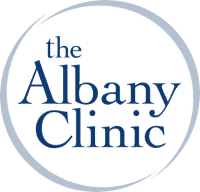Healing From Depression

The Albany Clinic • February 2, 2022
Millions of Americans, adults and children alike, suffer from depression. It’s a severe medical problem that can lead to other complications, but healing from depression isn’t a pipe dream – it’s a real possibility. Unfortunately, some people mistakenly choose to self-medicate, but other options like self-help or ketamine are worth looking into.
What Is Depression?
“ Depression is a mood disorder that causes a persistent feeling of sadness and loss of interest. Also called a major depressive disorder or clinical depression, it affects how you feel, think and behave and can lead to various emotional and physical problems. You may have trouble doing normal day-to-day activities, and sometimes you may feel as if life isn’t worth living.” But with time and care, you can manage the symptoms, sometimes with ketamine.
Facts About Depression
- About 17 million American adults have depression or about seven percent of the U.S. population aged 18 and older.
- It’s more common in women than in men.
- Nearly two million kids, ages three to 17, have been diagnosed with depression.
- Adults experiencing a depressive disorder or related symptoms have a 64 percent higher chance of getting coronary artery disease.
- According to the World Health Organization , it is estimated that five percent of adults suffer from depression worldwide.
Know The Symptoms
Symptoms of depression and other mood disorders can be different for everyone, but they include any of the following (sometimes happening together):
- Constant sadness or low moods
- You’re irritable, quick to anger, and feel hopeless
- You’re not interested in things you used to enjoy doing
- Low energy or easily fatigued
- Slow bodily movements and speech
- Restlessness and problems sitting still
- Cognitive issues
- Problems sleeping
- Trouble eating or weight fluctuations
- Mysterious aches that persist even with treatment
Ketamine And Depression
Ketamine has been around for decades, first introduced in the early 1960s as a new kind of pre-surgical anesthetic. Since then, it’s found use in humans and animals and gained widespread acclaim for treating wounded U.S. combat troops fighting in Vietnam. Soon, it was discovered that s-ketamine could reduce symptoms of chronic pain and mental illness, including mood disorders like depression. As a result, it was approved by the U.S. Food and Drug Administration for Treatment-Resistant Depression in 2019.
Healing From Depression
Healing from depression is never easy, but it’s possible. Unfortunately, one of the first roadblocks that most people face is the stark, harsh reality of admitting a problem – and opening oneself up to the need for help. Another roadblock is the still present stigma of mental illness today. Collectively, we’re becoming more accepting, compassionate, and understanding of depression and other mood disorders, but we’ve got a long way to go.
Once you’ve admitted there’s a problem and begin recognizing depression symptoms, nothing less than a full-scale assault on the illness will do. Some doctors, mental health professionals, and patients subscribe to an integrated approach to treating depression. Still, there are other ways to begin healing from depression you can try on your own.
- Set a routine for yourself. Establish structure and try to follow it.
- Set goals for yourself, even small ones. Depression can be overwhelming, physically and psychologically, and accomplishing a small task can boost self-esteem and confidence.
- When you’re depressed, your body lacks feel-good chemicals known as endorphins. One way to get them back is by exercising to fight depression. A brisk walk around the block, aerobics in your living room, or even a short visit to your local fitness center could boost endorphin levels and make you feel better.
- Plan healthy, nutritious meals. Eat more fruits and vegetables and less red meat and processed foods. Drink more water daily and avoid sugary or caffeine-rich beverages. And reduce or eliminate hard alcohol from your eating routine.
How To Diagnose & Treat Depression
Like other mood disorders, depression follows a mostly three-step process to be diagnosed.
Step 1 – Physical examination by a medical doctor to look for an underlying cause for depression symptoms.
Step 2 – If no medical cause is discovered, your doctor may recommend a psychiatric evaluation to discuss your thoughts, feelings, and behaviors as triggers for mental illness. Any personal or family history of mental illness will also be reviewed.
Step 3 – Compare depressive symptoms to the Diagnostic and Statistical Manual of Mental Disorders criteria.
Once diagnosed, your doctor may recommend psychotherapy, antidepressants, self-help, or other options, including ketamine therapy.
Final Thoughts
Depression shouldn’t be looked upon as a sign of weakness. It happens to millions and shouldn’t be ignored. If you have symptoms, talk to a medical or mental health professional for diagnosis.
The post Healing From Depression appeared first on The Albany Clinic.






